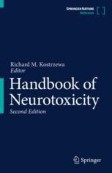Search
Search Results
-
The neutral CB1 antagonist AM6527 reduces ethanol seeking, binge-like consumption, reinforcing, and withdrawal effects in male and female mice
RationaleAlcohol use disorder (AUD) is a debilitating physiological and psychiatric disorder which affects individuals globally. The current...

-
Anticonvulsant Role of Adenosine is Blunted During Alcohol Withdrawal Syndrome in an Adult Zebrafish Model
Alcohol (ethanol) dependence and related disorders are life-threatening conditions and source of suffering for the user, family members and society....

-
Adolescent alcohol binge drinking and withdrawal: behavioural, brain GFAP-positive astrocytes and acute methamphetamine effects in adult female rats
RationaleAlcopop beverages are generally the first alcoholic beverage that young females drink which contain high levels of sugar and alcohol. The...

-

-
Ethanol Neurotoxicity
Ethanol or ethyl alcohol is an age-old substance with abuse potential that can lead to a myriad of organ damage as well as behavioral and...
-
N-Acetylcysteine normalizes brain oxidative stress and neuroinflammation observed after protracted ethanol abstinence: a preclinical study in long-term ethanol-experienced male rats
RationaleUsing a preclinical model based on the Alcohol Deprivation Effect (ADE), we have reported that N-Acetylcysteine (NAC) can prevent the...

-
Role of KCC2 in the Regulation of Brain-Derived Neurotrophic Factor on Ethanol Consumption in Rats
Alcohol use disorder (AUD) is a common and complex disorder resulting from repetitive alcohol drinking. The mesocorticolimbic dopamine (DA) system,...

-
Irisin attenuates ethanol-induced behavioral deficits in mice through activation of Nrf2 and inhibition of NF-κB pathways
This study aims to investigate the effect of irisin on ethanol-induced behavioral deficits and explore the underlying mechanisms. A mouse model of...

-
Alcohol availability during withdrawal gates the impact of alcohol vapor exposure on responses to alcohol cues
RationaleChronic intermittent ethanol (CIE) vapor inhalation is a widely used model of alcohol dependence, but the impact of CIE on cue-elicited...

-
Effects of CB1 receptor negative allosteric modulator Org27569 on oxycodone withdrawal symptoms in mice
Rationale/ObjectivesTargeting cannabinoid receptor type 1 (CB1R) has shown promise for treating opioid withdrawal symptoms. This study aimed to...

-
Ethanol Intake on Preclinical Models: Methods of Assessment and Effects on Dopamine Signaling
Alcohol (ethanol) use is associated with significant health problems. This prompted efforts to recreate ethanol intake in murine animal models. The...
-
Differential Effects of Chronic Ethanol Use on Mouse Neuronal and Astroglial Metabolic Activity
Chronic alcohol use disorder, a major risk factor for the development of neuropsychiatric disorders including addiction to other substances, is...

-
Targeted Inhibition of Upregulated Sodium-Calcium Exchanger in Rat Inferior Colliculus Suppresses Alcohol Withdrawal Seizures
The inferior colliculus (IC) is critical in initiating acoustically evoked alcohol withdrawal-induced seizures (AWSs). Recently, we reported that...

-
Sex-differences in anxiety, neuroinflammatory markers, and enhanced fear learning following chronic heroin withdrawal
Post-traumatic stress disorder (PTSD) and opioid use disorder (OUD) are comorbid in clinical populations. However, both pre-clinical and clinical...

-
Upregulation of dynorphin/kappa opioid receptor system in the dorsal hippocampus contributes to morphine withdrawal-induced place aversion
Aversive emotion of opioid withdrawal generates motivational state leading to compulsive drug seeking and taking. Kappa opioid receptor (KOR) and its...

-
The Inflammation/NF-κB and BDNF/TrkB/CREB Pathways in the Cerebellum Are Implicated in the Changes in Spatial Working Memory After Both Morphine Dependence and Withdrawal in Rat
We aimed to explore the impact of the cerebellum on the decline in spatial working memory following morphine dependence and withdrawal. Two groups of...

-
Genetics and epigenetics: paternal adolescent ethanol consumption in serotonin transporter knock-out rats and offspring sensitivity to ethanol
RationaleAlcohol use disorder (AUD) is shown to have an overall heritability of around 50%. One of the genes associated with AUD is SLC6A4 (solute...

-
Ethanol Neurotoxicity
Ethanol or ethyl alcohol is an age-old substance with abuse potential that can lead to a myriad of organ damage as well as behavioral and...
-
Front-Loaded Versus Low-Intermittent Phenobarbital Dosing for Benzodiazepine-Resistant Severe Alcohol Withdrawal Syndrome
IntroductionPhenobarbital is frequently used to manage severe alcohol withdrawal. The purpose of this study was to compare the incidence of...

-
Acetaldehyde via CGRP receptor and TRPA1 in Schwann cells mediates ethanol-evoked periorbital mechanical allodynia in mice: relevance for migraine
BackgroundIngestion of alcoholic beverages is a known trigger of migraine attacks. However, whether and how ethanol exerts its pro-migraine action...

